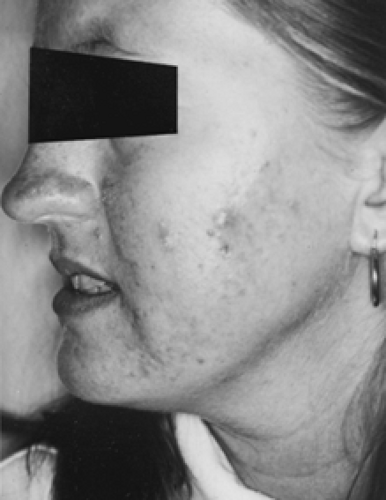ACNE
HORMONAL CONTROL OF SEBUM
PSUs, which are primarily sebaceous, are influenced by many factors, and once they are stimulated, their actions may lead to oily skin and acne lesions. The density of PSUs is greatest on the face and scalp (400–800 glands/cm2) and lowest on the extremities (50 glands/cm2).41 Androgen is unequivocally linked to stimulation of sebum production.42 Androgen stimulates sebaceous gland cell division and intracellular lipid synthesis.42 In animal studies that have examined the effects of testosterone and antiandrogens, estradiol has been shown to be an extremely potent inhibitor of sebum production. However, estradiol appears to have little or no effect on cell division. Corticosteroids have a stimulatory effect on sebaceous glands, and those progestins that have androgenic properties act at physiologic levels to stimulate sebaceous activity.
PREVALENCE AND SCORING
Acne is present to some degree in almost all individuals but occurs most commonly during puberty, when it is found in as
many as 50% of adolescent girls and 85% of boys. After adolescence, acne disappears in most subjects but persists in some individuals. In other subjects, acne appears during adult life. Patients with persistent acne during adulthood (and patients with severe adolescent acne) can benefit from a systemic treatment (Fig. 101-8).
many as 50% of adolescent girls and 85% of boys. After adolescence, acne disappears in most subjects but persists in some individuals. In other subjects, acne appears during adult life. Patients with persistent acne during adulthood (and patients with severe adolescent acne) can benefit from a systemic treatment (Fig. 101-8).
Acne may be graded according to several methods. An easy method is to score acne on a scale of 0 to 3.43 In the modified method, the absence of lesions is scored as 0. Grade 1 (mild) lesions are characterized by comedones, with either no or only a few inflammatory papules or pustules. Grade 2 (moderate) lesions are characterized by numerous inflammatory lesions but with rare cystic activity. Grade 3 (severe) lesions are the worst lesions and are characterized by the presence of innumerable inflammatory papules or pustules as well as cysts. For research purposes, use of the method that scores the severity of lesions from 0 to 9 is preferable.44
PATHOGENESIS
Acne is a multifactorial disease in which androgens have a central role. Four processes determine the appearance of the acneic skin lesions45: (a) excessive keratinization of the infra-infundibulum and cohesion of horny cell masses that lead to retention of hyperkeratosis; (b) increased sebum production; (c) bacterial colonization; and (d) inflammation (Fig. 101-9).
 FIGURE 101-9. Electron photomicrograph of comedo formation beginning in infra-infundibulum. Large numbers of Propionibacterium acnes are present in the pilosebaceous canal. Keratohyalin is prominent. Cells of horny layer remain intact and begin to adhere to each other. Many cells contain lipid droplets not seen in normal infundibulum. (From Knutson DD. Comedo formation: ultrastructure. In: Frank SB, ed. Acne: update for the practitioner. New York: Yorke Medical Books, 1979:81.)
Stay updated, free articles. Join our Telegram channel
Full access? Get Clinical Tree
 Get Clinical Tree app for offline access
Get Clinical Tree app for offline access

|



